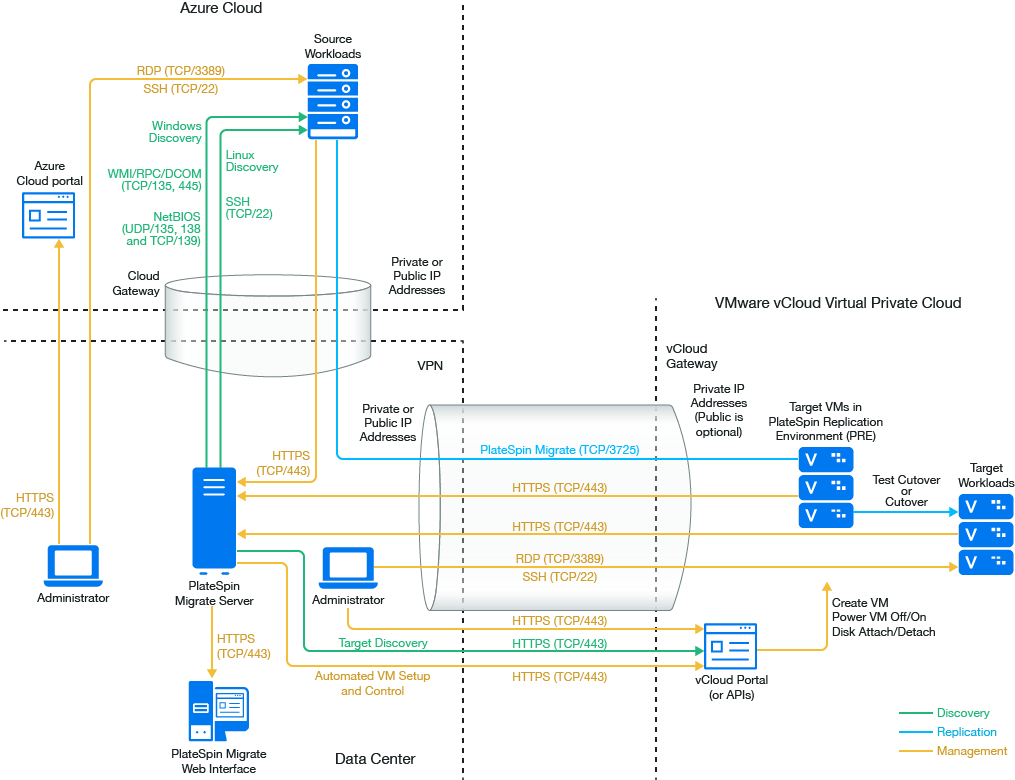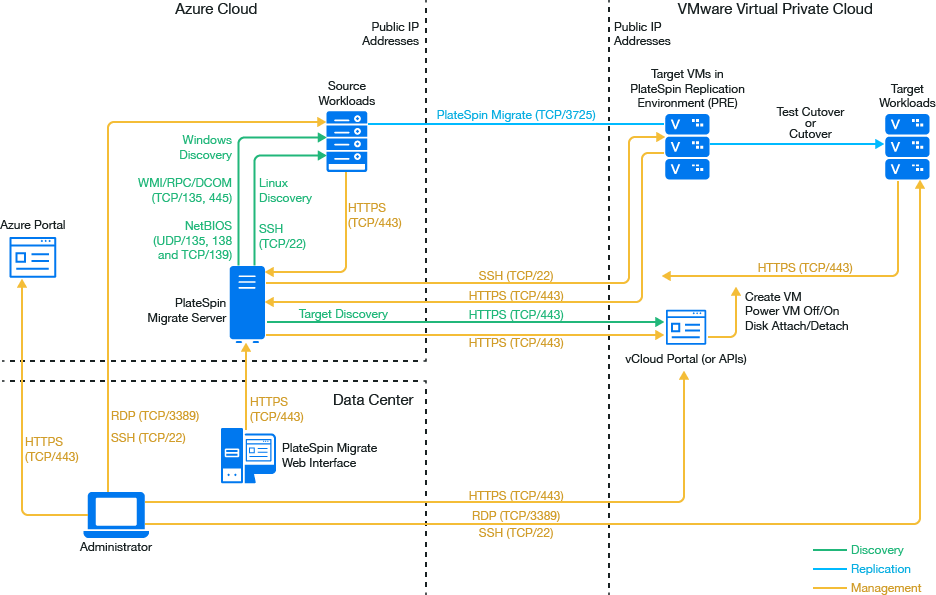12.4 Prerequisites for C2C Migration from Azure to vCloud
PlateSpin Migrate supports migration of workloads from Microsoft Azure to VMware vCloud Director.
12.4.1 Deployment for C2C Migration from Azure to vCloud
For migration of workloads from Microsoft Azure to VMware vCloud Director, deploy a PlateSpin Migrate server on premise in your source network. With an on-premise Migrate server, site-to-site VPN gateways are required between the data center and Azure and between the data center and vCloud. Figure 12-4 shows the location of various components in your Azure, vCloud, and data center migration environments and the communications between them.
Figure 12-4 Migrate Server on Premise for Migration from Azure to vCloud

You can alternatively deploy the PlateSpin Migrate server from the Azure Marketplace in the source Azure environment. No VPN is required. With the Azure server in the same network security group as the source workloads, you can use discovery to add workloads to Azure. Use data encryption to secure data for replications over the public Internet. Figure 12-5 shows the location of various components in your Azure, vCloud, and data center migration environments and the communications between them.
NOTE:Figure 12-5 depicts source workloads and the Migrate server in the same network security group. If they are in different security groups, use Migrate Agent on the source workload to register the workload and send its inventory details to PlateSpin Migrate server using HTTPS (TCP/443). See Requirements for Workload Registration and Registering Workloads and Discovering Details with Migrate Agent.
Figure 12-5 Migrate Server in Azure for Migration from Azure to vCloud with No VPNs

12.4.2 Requirements for Migration to vCloud
To prepare your target vCloud environment, review the information in Planning For Migrating Workloads to VMware vCloud Director.
Ensure that the source workload is supported by the target vCloud configuration.
12.4.3 Requirements for Migrating Workloads from Azure to vCloud
For source workloads in Azure:
-
Azure automatically adds the Remote Desktop Protocol (RDP) port (TCP/3389) and Secure Shell (SSH) port (TCP/22) in the Azure Security Group for the source workload VMs. You must manually add other ports to the source workload’s Security Group that are required by PlateSpin Migrate to provide migration services, such as Port 3725 for replication traffic and Port 443 for HTTPS traffic.
-
For Windows workloads, use a user name and password.
-
For Linux workloads, use the root user or root equivalent user.
To use an on-premise Migrate server for migration of workloads from Azure to vCloud:
-
Deploy a site-to-site VPN between your data center and your Azure environment.
-
Deploy a site-to-site VPN between your data center and your VMware vCloud Virtual Private Cloud.
-
Because you are using VPNs with an on-premise Migrate server, you can use a private IP address for the Migrate server.
-
Ensure that your source and target network meet the following requirements.
-
Migrate Agent is not required because a VPN is available, but it would also work. For network ports and firewall requirements for registration, see Requirements for Workload Registration.
To use a cloud-based Migrate server for migration of workloads from Azure to vCloud without a VPN:
-
Deploy a PlateSpin Migrate server in the source Azure network environment. Ensure that your non-VPN migration environment meets the Requirements for C2C Non-VPN Migrations.
-
In the PlateSpin Configuration settings on the Migrate server:
-
(Migrate Server in Azure) ServerIsHostedInCloud: Remove the value of azure from the ServerIsHostedInCloud parameter to enable the Add Target dialog to provide all target types for selection. When you set up the vCloud target, select the VMware vCloud Organization option.
-
12.4.4 Checklist for Automated Migration from Azure to vCloud
|
Task |
Description |
|---|---|
|
Figure 12-4, Migrate Server on Premise for Migration from Azure to vCloud Figure 12-5, Migrate Server in Azure for Migration from Azure to vCloud with No VPNs |
|
|
|
|
|
|
|
|
|
Configuring Migration of a Workload to VMware vCloud Director |
|